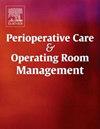Comparison of stress response, post-operative complications, and recovery between the enhanced recovery after surgery (ERAS) vs standard protocol in patients undergoing laparoscopic cholecystectomy: A prospective observational study from northern India
IF 1
Q2 Nursing
Perioperative Care and Operating Room Management
Pub Date : 2025-04-04
DOI:10.1016/j.pcorm.2025.100489
引用次数: 0
Abstract
Background
The goal of the Enhanced Recovery After Surgery (ERAS) protocol is to reduce the surgical stress response to promote better postoperative recovery. Widespread adoption of the ERAS initiative has resulted in extending standards for various surgical specialties, especially in colorectal surgery. In this study, patients undergoing laparoscopic cholecystectomy had their perioperative stress response, postoperative problems, and rehabilitation assessed through a modified ERAS procedure.
Methods
120 patients were enrolled in a prospective observational research and randomly assigned to the ERAS (case) or standard treatment (control) groups. Important elements of the ERAS procedure were multimodal analgesia, carbohydrate loading, and preoperative education. Measurements of serum glucose, cortisol, total leukocyte count (TLC), and C-reactive protein (CRP) were performed both before and after surgery.
Result
The postoperative serum glucose and cortisol levels were significantly lower (p < 0.001) in the ERAS group. Serum glucose levels in the ERAS group were greater 6 h after surgery and right before (p < 0.001). Following surgery, the control group's serum cortisol levels were considerably higher (p < 0.001). Additionally, the ERAS group experienced fewer problems at discharge, including fever (p = 0.01), vomiting (p = 0.004), and nausea (p = 0.03), and had lower PONV intensity scores at 24 h (p = 0.012). Furthermore, the ERAS group started oral feedings sooner and spent a considerably lower amount of time in the hospital (p < 0.001).
Conclusion
The modified ERAS protocol is beneficial in enhancing perioperative care and outcomes by reducing the surgical stress response and improving recovery in patients undergoing laparoscopic cholecystectomy.
来自印度北部的一项前瞻性观察研究:腹腔镜胆囊切除术患者的应激反应、术后并发症和术后增强恢复(ERAS)与标准方案之间的比较
手术后增强恢复(ERAS)方案的目标是减少手术应激反应,促进更好的术后恢复。ERAS倡议的广泛采用导致了各种外科专业标准的扩展,特别是在结直肠手术中。在本研究中,接受腹腔镜胆囊切除术的患者通过改良的ERAS程序评估围手术期应激反应、术后问题和康复情况。方法将120例患者纳入前瞻性观察研究,随机分为ERAS组(病例组)和标准治疗组(对照组)。ERAS手术的重要内容是多模式镇痛、碳水化合物负荷和术前教育。手术前后分别测定血清葡萄糖、皮质醇、总白细胞计数(TLC)和c反应蛋白(CRP)。结果术后血清葡萄糖、皮质醇水平明显降低(p <;ERAS组为0.001)。ERAS组患者术后6 h及术前血糖水平均高于对照组(p <;0.001)。手术后,对照组的血清皮质醇水平明显升高(p <;0.001)。此外,ERAS组在出院时出现的问题较少,包括发烧(p = 0.01)、呕吐(p = 0.004)和恶心(p = 0.03),并且24 h时PONV强度评分较低(p = 0.012)。此外,ERAS组开始口服喂养的时间更早,住院时间也更短(p <;0.001)。结论改进后的ERAS方案可减少腹腔镜胆囊切除术患者的手术应激反应,提高围手术期护理水平和预后。
本文章由计算机程序翻译,如有差异,请以英文原文为准。
求助全文
约1分钟内获得全文
求助全文
来源期刊

Perioperative Care and Operating Room Management
Nursing-Medical and Surgical Nursing
CiteScore
1.30
自引率
0.00%
发文量
52
审稿时长
56 days
期刊介绍:
The objective of this new online journal is to serve as a multidisciplinary, peer-reviewed source of information related to the administrative, economic, operational, safety, and quality aspects of the ambulatory and in-patient operating room and interventional procedural processes. The journal will provide high-quality information and research findings on operational and system-based approaches to ensure safe, coordinated, and high-value periprocedural care. With the current focus on value in health care it is essential that there is a venue for researchers to publish articles on quality improvement process initiatives, process flow modeling, information management, efficient design, cost improvement, use of novel technologies, and management.
 求助内容:
求助内容: 应助结果提醒方式:
应助结果提醒方式:


